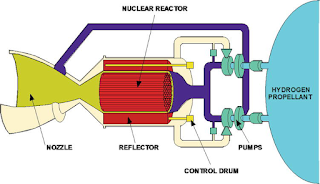Plutonium (pronounced ploo-toh-nee-uhm)
A radioactive chemical element that is artificially derived from uranium, plutonium is a highly toxic metallic transuranic element. It occurs in trace amounts in uranium ores and is produced in a nuclear reactor by neutron bombardment of uranium-238. The most stable and important isotope, plutonium-239, readily undergoes fission and is used as a reactor fuel in nuclear power stations and in nuclear weapons. Symbol: Pu; atomic no: 94; half-life (plutonium 239): 24,360 years; valency: 3, 4, 5, or 6; relative density (alpha modification): 19.84; melting point: 1184°F (640°C); boiling point: 5846°F (3230°C); specific gravity 19.84. Its longest-lived isotope is Plutonium 244 with a half-life of 77 million years.
1941:
The construct was Pluto (the (now dwarf-) planet), +–ium (the element ending
suffix from the Latin -um (neuter singular morphological suffix) and based on
Latin terms for metals such as ferrum (iron).
The –ium suffix (used most
often to form adjectives) was applied as (1) a nominal suffix (2) a
substantivisation of its neuter forms and (3) as an adjectival suffix. It was associated with the formation of
abstract nouns, sometimes denoting offices and groups, a linguistic practice
which has long fallen from fashion. In
the New Latin, as the neuter
singular morphological suffix, it was the standard suffix to append when forming
names for chemical elements. Plutonium was discovered at the
University of California, Berkeley and so named because it follows the recently
discovered neptunium in the periodic table and, at the time, Pluto followed
Neptune in the Solar System. The name
plutonium earlier had been proposed for barium and was used sometimes in this
sense early in the nineteenth century.
Pluto was from the Latin Plūtō, from the Ancient Greek Πλούτων (Ploútōn) (god of the underworld”). In Greek mythology & Roman mythology, Pluto is remembered as the Greco-Roman god of the underworld but the ultimate origin was the Greek Ploutōn (god of wealth), from ploutos (wealth, riches (thought probably used originally in the sense of “overflowing”), from the primitive Indo-European root pleu- (to flow); the alternative Greek name Hades is also related to wealth because it is from beneath the earth that lie valuable metals & precious gems. Although some have expressed doubt, the accepted history is it was then eleven year old Ms Venetia Burney (1918–2009) who suggested the name Pluto for the newly discovered (then) planet, aware of the procedure apparently because her uncle had earlier nominated Phobos and Deimos as names for the moons of Mars. In 2006, the humorless International Astronomical Union (IAU) made its scandalous decision to declare, on highly technical grounds, that Pluto was not a planet but a mere dwarf and this inspired the American Dialect Society to coin the verb "to pluto" meaning "to demote or devalue something".
Uranium (pronounced yoo-rey-nee-uhm)
A white, lustrous, radioactive, metallic element, it has compounds used in photography and in coloring glass, the 235 isotope used in atomic and hydrogen bombs and as nuclear fuel in fission reactors. A radioactive silvery-white metallic element of the actinide series, it occurs in several minerals including pitchblende, carnotite, and autunite. Symbol: U; atomic no: 92; atomic wt: 238.0289; half-life of most stable isotope (uranium 238): 451 × 109 years; valency: 2-6; relative density: 18.95 (approx.); melting point: 2075°F (1135°C); boiling point: 7473°F (4134°C); specific gravity 18.95.
1789: The construct was Uranus + (the planet) the –ium. The element was named (using the conventions of Modern Latin) because the discovery of the planet had recently been announced. Uranus was from the Latin Ūranus, from the Ancient Greek Οὐρανός (Ouranós), from οὐρανός (ouranós) (sky, heaven).
Uranus Fudge Factory, 14400 State Hwy Z, St Robert, Missouri 65584, USA.
Nuclear Weapons
Of the first three atomic bombs built in 1945, two used plutonium as fissile material while one used uranium. Two of the many problems faced in the project were (1) production of uranium of the required purity was slow but a bomb of this type was (relatively) simple to produce and (2) plutonium was more abundant but the engineering to create such a bomb was intricate, the results uncertain. Two designs were thus concurrently developed: a (relatively) simple trigger-type device and a more complex implosion-type. Trinity, code-name for the world’s first detonation of a nuclear device (New Mexico, July 1945), was one of the latter, an implosion-type plutonium bomb. It was chosen because this was a genuine test, there being no certainty it would work whereas the trigger-type uranium device, ultimately dropped on Hiroshima a month later, was never tested because the scientists and engineers had such confidence in its design. After the war, it was assumed the somewhat inefficient trigger mechanism wouldn’t again be used but technical problems saw production temporarily resumed, these stop-gap A-Bombs remaining in service until 1951.
Models of short and medium-range ballistic missiles at DPRK Annual Flower Show, Pyongyang, April 2013.
Lindsay Lohan in mushroom cloud T-shirt.
It’s no longer certain the uranium-based bomb used again Hiroshima in August 1945 remains a genuine one-off. It’s certain that in the sixty-odd years since Trinity, every nuclear weapon except the Hiroshima device was plutonium-based but, beginning in 2006, the DPRK (the Democratic People's Republic of Korea (North Korea)) conducted six nuclear tests and, despite advances in monitoring and detection techniques, it’s not clear what material was used although the consensus is all were fission (A-Bombs) and not fusion (H-Bombs) devices. The tests, by historic standards, were low-yield, suggesting uranium, but this could be misleading because even a failed test of can produce a nuclear blast called a fizzle (when a detonation fails grossly to meet its expected yield). The DPRK's programme will have had the odd fizzle but then so has every nation at some stage of the process but by historic standards it must be judged a success. It was hampered by sanctions and international opposition (Beijing and Moscow as unwilling as Western powers to help the hermit kingdom join the nuclear club) but achieved the necessary technology transfer by swapping ballistic missile blueprints with Pakistan which had detonated it's first fission device in 1998 but lacked a robust delivery system to counter the "nuclear threat" from India which had tested as early as 1974. That transaction was illustrative of one of the two concerns the West harbours about the DPRK bomb (1) some sort of accident (and that covers everything from an unplanned detonation in some unfortunate place to a missile launch which malfunctions and hits a populated area) and (2) nuclear proliferation which happens because the technology is used by Pyongyang in the barter economy as a trade for something desirable but not available because of sanctions or other trade restrictions.




















